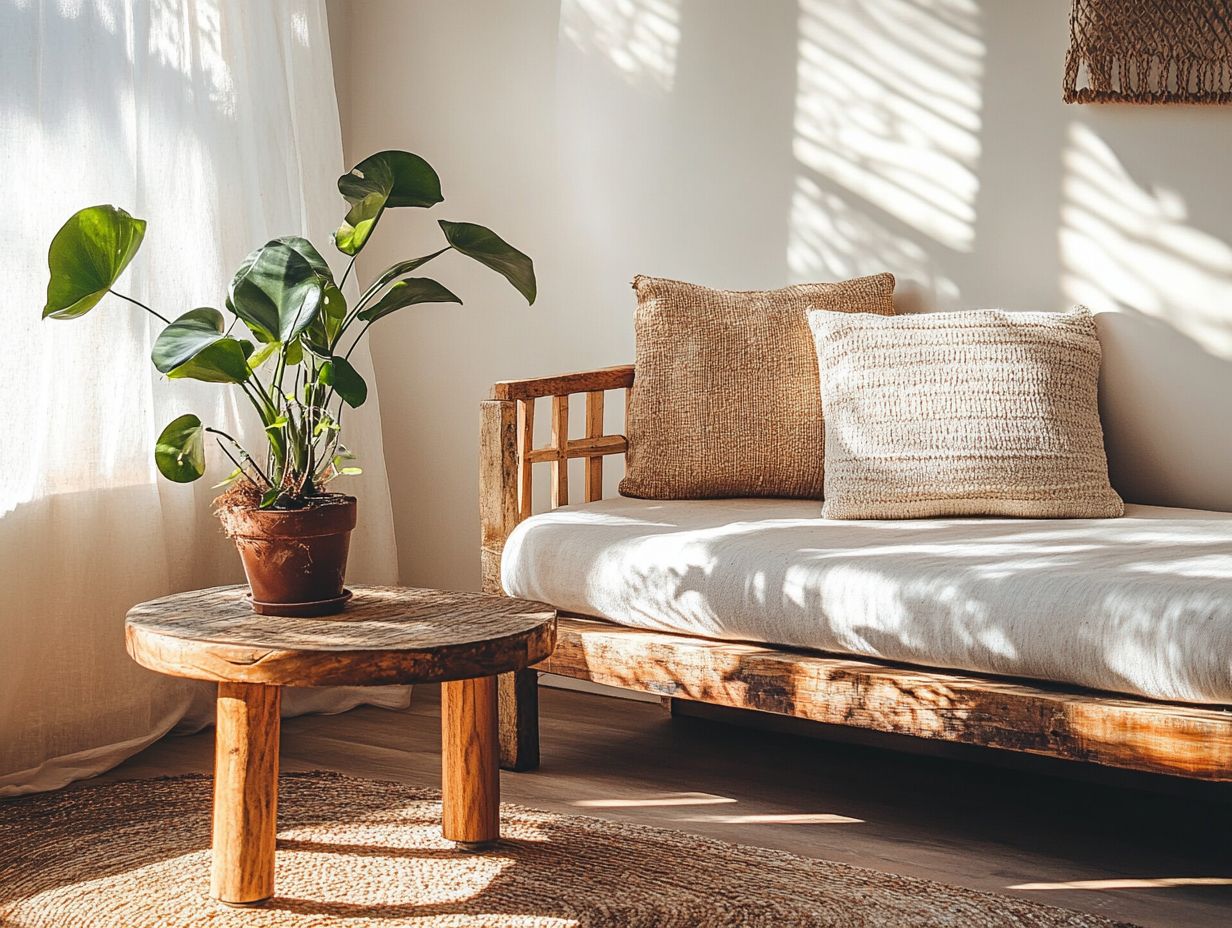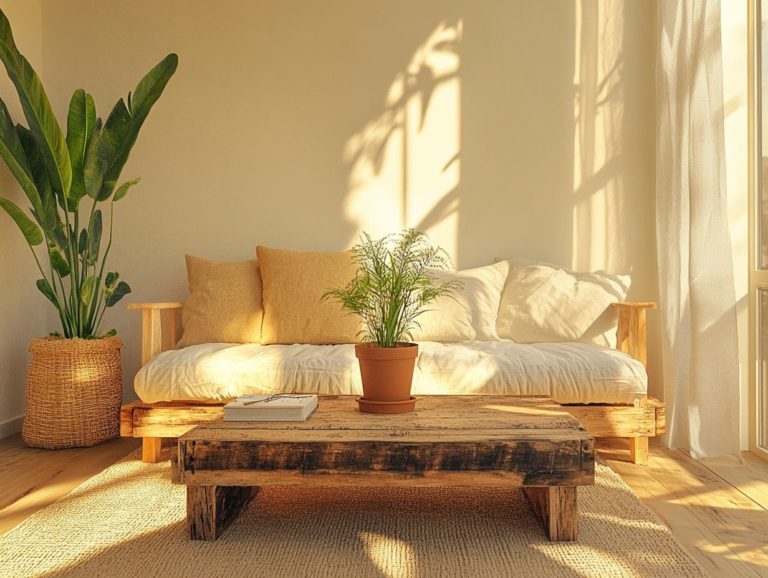Why Sustainable Materials Matter in Home Design
In a world that is becoming ever more conscious of its environmental footprint, the demand for sustainable home design has reached a critical point.
This article delves into the pivotal role of sustainable materials, shedding light on their environmental impact and the health benefits they offer.
You will explore a variety of sustainable materials, ranging from natural and renewable options to recycled and reclaimed resources. You’ll also find practical tips for seamlessly incorporating these materials into your designs while maintaining a balance between costs and upkeep.
Now is the perfect time to create a greener future for your home!
Contents
- Key Takeaways:
- The Importance of Sustainable Materials
- Types of Sustainable Materials
- Incorporating Sustainable Materials in Home Design
- Cost and Maintenance Considerations
- Frequently Asked Questions
- Why are sustainable materials important in home design?
- What are some examples of sustainable materials used in home design?
- How do sustainable materials benefit the environment?
- What makes a material sustainable?
- Can sustainable materials be cost-effective for homeowners?
- How can homeowners incorporate sustainable materials into their home design?
Key Takeaways:

- Choosing sustainable materials positively impacts the environment and health.
- Natural, renewable, recycled, and reclaimed materials are eco-friendly options.
- Balancing sustainability and budget is key, considering maintenance and durability.
Defining Sustainability in Home Design
Sustainability in home design invites you to adopt a whole view that prioritizes environmental integrity and human health through the principles of sustainable interior design. This practice balances aesthetics with functionality, ensuring that the eco-friendly materials you choose like bamboo and recycled metals not only look good but also enhance indoor air quality and psychological well-being.
By integrating natural elements and embracing design that connects people with nature, you can cultivate spaces that reduce your carbon footprint while promoting overall wellness. This commitment to sustainability aligns with guidelines from renowned organizations such as the Environmental Protection Agency (EPA) and the General Services Administration (GSA), putting building performance and resource conservation front and center in modern home design.
Incorporating green technologies, such as solar panels and energy-efficient appliances, will significantly contribute to your energy savings and help lower utility costs. Emphasizing waste reduction strategies think composting and using recycled materials in construction not only minimizes your contributions to landfills but also supports a thriving circular economy.
By selecting EPA-approved products, you ensure that your investments meet rigorous standards for safety and environmental responsibility, fostering a healthier living space. As more individuals adopt this sustainable mindset, the ripple effect can inspire broader societal change, cultivating a culture that values long-term ecological balance and resource stewardship.
The Importance of Sustainable Materials
Sustainable materials hold immense significance in home design, serving not only to conserve resources but also to substantially lessen the environmental impact typically linked to conventional building practices. Understanding why your home needs more sustainable materials can further enhance your commitment to eco-friendly living.
By selecting sustainable options, such as low VOC materials and those certified by respected organizations like the Forest Stewardship Council, you can effectively reduce your carbon footprint while enhancing the durability of your home furnishings.
Embracing these materials aligns seamlessly with the broader aims of sustainable interior design, fostering both ecological harmony and visual elegance in your living space.
Environmental Impact
The environmental impact of traditional construction practices is significant. It results in excessive waste and substantial carbon footprints that exacerbate global issues like climate change and resource depletion.
If you embrace sustainable materials in home design, you can transform this narrative. This promotes waste reduction and enhances environmental resilience.
If you choose low-VOC options and recycled materials, you can lower your ecological footprint. You ll also create a healthier living environment.
Take, for example, conventional cement production, which accounts for about 7% of global carbon dioxide emissions. Eco-friendly alternatives like hempcrete can drastically reduce these emissions. Using reclaimed wood not only reduces demand for new lumber. It also helps preserve vital forest ecosystems. Research indicates that employing recycled materials can result in up to an 80% decrease in energy consumption during production.
By incorporating these sustainable practices into your projects, you actively contribute to a circular economy that promotes both environmental health and social responsibility.
Health Benefits
Incorporating sustainable materials into your home design improves indoor air quality and enhances your psychological well-being. By opting for eco-friendly materials like natural fibers and non-toxic finishes, you minimize harmful emissions and promote better health outcomes.
Integrating elements of biophilic design an approach that recognizes our innate affinity for nature allows your indoor spaces to harness the calming effects of natural light, lush greenery, and organic shapes. The presence of plants not only improves air quality but also fosters a sense of tranquility, uplifting your mood and reducing stress levels. Studies show that environments rich in natural elements enhance focus and cognitive function. This creates a more productive atmosphere.
Choosing sustainable materials often leads you to select products that are more durable and easier to maintain, instilling a sense of stability and comfort in your living space.
Types of Sustainable Materials

Sustainable materials come in a rich variety, from natural and renewable options to cutting-edge recycled materials, each presenting distinct advantages for the eco-conscious homeowner.
By integrating resources such as nanocellulose and bamboo into your space, you can achieve a design that not only aligns with sustainable principles but also showcases your dedication to resource conservation and environmental well-being.
Choosing recycled materials not only reduces waste. It also adds character and flair to your home furnishings.
Explore the possibilities of sustainable materials. Your choices can make a difference!
Natural and Renewable Materials
Natural and renewable materials like bamboo and natural fibers play a pivotal role in sustainable home design. They offer eco-friendly options that minimize your environmental footprint and enhance indoor air quality. These materials are often low in VOCs (volatile organic compounds), promoting a healthier living space while beautifully showcasing the wonders of nature within your interiors.
By using these materials, you showcase a genuine commitment to sustainability and resource conservation. This aligns perfectly with the principles of design that connects with nature.
The versatility of materials such as cork and reclaimed wood allows for easy integration into various design styles, whether you prefer rustic charm or modern elegance.
For instance, cork flooring is not just a treat for your feet; it also provides excellent sound insulation, making it a fantastic choice for bustling households. You can transform reclaimed wood into breathtaking feature walls or cabinetry, adding character and a distinctive aesthetic to any room.
By choosing these materials, you can transform your home into a stunning, eco-friendly oasis that supports sustainable living practices, benefiting both your well-being and the planet.
Recycled and Reclaimed Materials
Recycled and reclaimed materials are essential for sustainable interior design. They focus on waste reduction and resource conservation while adding a unique flair to your home. By repurposing materials like reclaimed wood and recycled metal, you create stylish, eco-friendly spaces that reflect your commitment to sustainability. This approach diminishes the need for new resources and significantly lessens your overall environmental impact.
Imagine a stunning kitchen crafted from reclaimed barn wood. It exudes rustic charm and carries a story from its previous life. Think of an urban loft incorporating salvaged bricks and recycled glass countertops; it showcases how these materials minimize construction waste while elevating aesthetic appeal.
Utilizing reclaimed tiles in your bathroom results in unique designs and reduces landfill contributions, highlighting the beauty of eco-conscious choices. By embracing these sustainable practices in your home design, you enhance visual allure and cultivate an atmosphere rooted in responsibility and creativity.
Incorporating Sustainable Materials in Home Design
Incorporating sustainable materials into your home design demands a thoughtful approach, as it aligns with principles centered on environmental health and wellness.
By considering factors like energy efficiency and indoor air quality, you can choose materials that elevate the aesthetics and functionality of your spaces.
This dedication to sustainable interior design nurtures a healthier living environment for you and your loved ones while playing a vital role in the planet’s long-term sustainability.
Tips for Choosing and Using Sustainable Materials
Choosing and using sustainable materials requires careful consideration of indoor air quality, energy efficiency, and overall environmental impact. Ensure that the materials you select align with eco-friendly practices. Prioritize low VOC options from responsible suppliers; these choices contribute to a healthier living environment and offer long-lasting durability.
By following sustainable design principles, you create spaces that are both stunning and environmentally conscious.
To enhance the sustainability of your home design projects, assess materials for their lifecycle impact. Consider how they are harvested, processed, and disposed of. Opting for local materials reduces transportation emissions, while selecting products made from recycled content minimizes waste.
Familiarize yourself with certifications like FSC (Forest Stewardship Council) for wood products and ENERGY STAR ratings for appliances to refine your decision-making process.
Stay mindful of the energy sources used in manufacturing these materials. By taking these thoughtful steps, you can ensure your choices meet aesthetic desires while contributing to a more sustainable future.
What sustainable materials are you excited to use in your home? Let s create beautiful spaces that respect our planet!
Cost and Maintenance Considerations

Cost and maintenance considerations play a pivotal role in the choice of sustainable materials for home design. These factors impact both the feasibility and longevity of your project. While some environmentally friendly choices may come with a higher upfront price tag, their long-term durability and lower maintenance needs can lead to reduced expenses over time.
Homeowners should carefully evaluate these factors against their commitment to sustainability. It’s essential to select materials that not only fit within their budget but also contribute positively to environmental health.
Balancing Sustainability and Budget
Balancing sustainability and budget is a familiar challenge for homeowners who want to incorporate eco-friendly materials into their designs. These options often come with a hefty price tag. However, with thoughtful planning and research, it’s entirely feasible to discover sustainable materials that fit within your budget while honoring ecological principles.
Explore avenues like recycled materials or sourcing from local suppliers to ensure your design choices support both your financial goals and commitment to the environment.
To navigate this balance effectively, prioritize your needs. Distinguish between essential sustainable features and those that are merely luxurious. Seeking community workshops can reveal DIY strategies that cut costs and deepen your investment in sustainability.
Networking with local artisans might unveil unique, cost-effective materials that highlight ecological responsibility while adding character to your projects. By embracing these actionable strategies, transform your sustainability aspirations into tangible reality without straining your budget.
Long-term Maintenance and Durability
When selecting sustainable materials for home design, long-term maintenance and durability should be at the forefront of your decision-making process. These factors significantly impact the overall performance and lifespan of your structure. Choosing materials that are both durable and low-maintenance extends their life cycle and helps reduce waste and environmental impact over time.
Prioritize sustainable options that meet your upkeep needs while enhancing the aesthetic appeal of your spaces.
For instance, opting for reclaimed wood adds unique character to your home while providing remarkable sturdiness and resilience, minimizing the need for frequent replacements. Similarly, materials like bamboo and recycled metal are celebrated for their strength and sustainability. They can endure wear and tear while contributing to a greener planet.
By making thoughtful choices, significantly cut down on maintenance costs and focus more on enjoying your living environment.
Ultimately, these sustainable decisions reflect your commitment to durability. This ensures that your investments deliver both performance and style for years to come.
Frequently Asked Questions
Why are sustainable materials important in home design?
Sustainable materials are important because they have a lower impact on the environment, are healthier for homeowners, and can reduce long-term costs for maintenance and repairs.
What are some examples of sustainable materials used in home design?

Examples of sustainable materials include bamboo flooring, recycled glass countertops, reclaimed wood furniture, and energy-efficient appliances.
How do sustainable materials benefit the environment?
Sustainable materials help conserve natural resources, reduce pollution and waste, and promote a healthier ecosystem for plants and animals.
What makes a material sustainable?
Sustainable materials are typically renewable, non-toxic, and have minimal environmental impact in their production, use, and disposal.
If you’re interested in learning more about sustainable home design, explore our resources for additional insights and tips!
Can sustainable materials be cost-effective for homeowners?
Yes, sustainable materials can save you money over time. They are durable and energy-efficient, which lowers utility bills and reduces the need for repairs.
How can homeowners incorporate sustainable materials into their home design?
Homeowners can use sustainable materials in flooring, countertops, furniture, and insulation.
Choosing energy-efficient appliances and installing solar panels can also significantly reduce your environmental impact.






